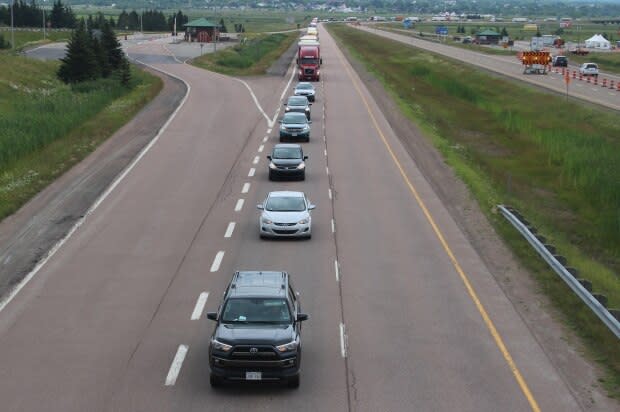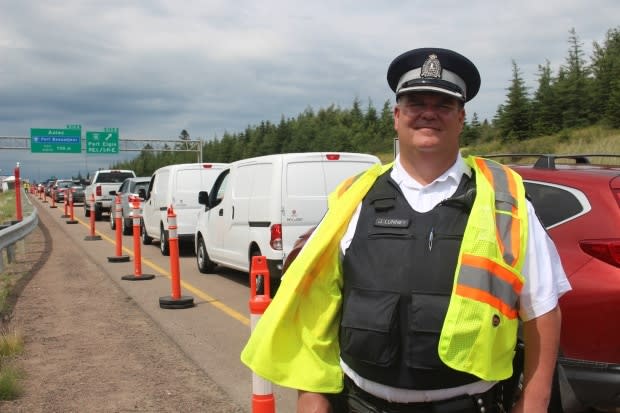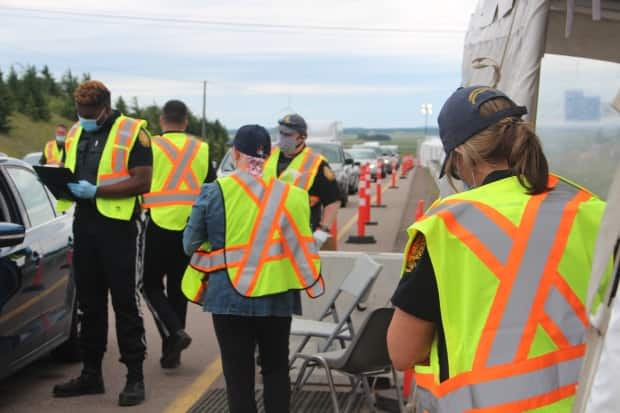Road test: It's a lot harder to get into New Brunswick than out of it

There was a noticeable difference for vehicles on the Trans-Canada Highway pulling up to the border between New Brunswick and Nova Scotia at lunchtime on Wednesday — wait times.
While approaching the border heading into Nova Scotia, there was a daunting lineup of traffic stalled on the other side of the median, backed up for several kilometres waiting to enter New Brunswick.
But for vehicles driving into Nova Scotia, there was no wait and just a couple of cars pulled over at the checkpoint outside Amherst.
Wednesday marked the sixth day since the Atlantic bubble opened interprovincial borders, yet traffic into New Brunswick at Aulac continues to enter the province at a snail's pace.
Traffic to New Brunswick backlogged
After turning around at Amherst, CBC News joined the long line of traffic waiting to cross into New Brunswick.
At 1:43 p.m. traffic was backed up about five kilometres from the Aulac checkpoint.

The bumper-to-bumper traffic was a mix of personal vehicles and transport trucks and, although the lineup was continuously moving, it took 45 minutes before reaching the New Brunswick entrance.
At that point, vehicles were divided into two lanes. One for commercial vehicles and people who have express passes for people who travel between the two provinces regularly.
The other lane was at a halt while peace officers screened each vehicle with a questionnaire that required proof of residency in the Atlantic bubble, contact information for all passengers in the vehicle and a list of questions asking about COVID-19 symptoms.
That process took about five minutes and there were multiple cars being served at once, to help speed up the process.
Tweaks being made
Although on day six of the Atlantic bubble there were still traffic woes, the situation has improved somewhat from the lengthy delays on the first day, last Friday.
John Lunney, acting deputy chief of inspection and enforcement at the Department of Public Safety, said the second lane opened on Tuesday to help move traffic through the checkpoint faster.

"We are trying to keep traffic moving, people need to come prepared and be patient," he said, adding that they're making adjustments each day.
"They've gone from sometimes hundreds to thousands of vehicles, right, so it's just been an adjustment."
Lunney said they waved traffic through the checkpoint on Tuesday at one point while they were opening the second lane. On the first day of the bubble, traffic was waved through for a couple of hours to deal with the backlog of vehicles.
According to data released by the province, 6,300 vehicles crossed the border at the Aulac checkpoint on Wednesday.
Despite making adjustments to help speed up the process, Lunney said people should expect delays while approaching the New Brunswick border. He said they're hoping to eventually add a third lane to help push traffic through faster.

Lunney wouldn't comment on why traffic was backed up on the New Brunswick side but not the Nova Scotia side.
Lunney said peak traffic hours at the Aulac checkpoint are Monday to Friday 6:30 a.m. to 9:30 a.m., 11:00 a.m. to 1 p.m. and 4 p.m. to 6:30 p.m. He said Sunday afternoon is a busy time, too.


